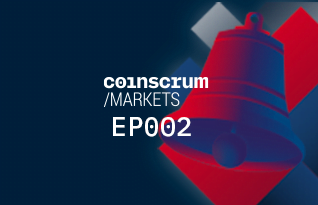Chris Bendiksen, head of research at CoinShares, talked to Pavel Moravec, CTO at SlushPool, and
Dr. Philipp Kallerhoff, co-founder and partner at Protos Asset Management, about the bitcoin mining landscape. He asked if the profitability of bitcoin mining plays into the bitcoin price, bringing in an argument by Matt D’Souza, who says that when mining profits are excellent, fewer coins end up hitting the market, which constricts supply further, which creates a virtuous cycle and feeds into the budding bull market. Protos Asset Management’s Kallerhoff fielded the question, saying:
“I really like his argument…And it’s a great argument. I think that is partly true at least for the miners that we work for that, of course, they take more market exposure if they don’t have to sell all the coins to kind of keep the company running. On the other hand, I think we will see a massive…the halving’s going to happen and they will produce only half the coins. So therefore, their profitability will drop unless bitcoin like you said will go to $9,000-9,500 and then they will have some flexibility. But overall, I think they have now more free coins of course than they will have next week, right? So already that I think will have an impact and they have to sell more of the coins that they get. Total volume of course will just be half, right? So that’s the counterargument.”
Bendiksen asked Moravec about access to capital and financing, mentioning firmware optimization. And whether more edge will be gotten in the overall market from further optimization or if we are getting to the edge there too. Moravec responded,
“There is still a lot of space in this area, I would say. This is one of the last pieces of the whole mining ecosystem which needs to be professionalized more. We are trying to do that. Let’s look at the S9s. You can, by running different versions of firmware you can get I’d say 20% of hashrate output from the machine just by running different firmware and doing all the proper setup from the hardware perspective. This is too large…being used by miners and this is going to happen for S17s, S19s, all machines out there. The manufacturers are not easing the hardware – their firmware is not using the hardware on the very edge. And it kind of depends on various miners’ risk, how they feel about risking the hardware and pushing the hardware to the very limits. There is certainly a risk by running more efficient firmware or over-clucking the hardware. Yeah, but there is still a large space, much larger than in any other single point I can imagine right now with hardware you can get.”
Bendiksen asked about the cost of competition and the reinvestment cycle for miners, saying it drives up difficulty which drives miners to have to reinvest in more efficient hardware, especially if they’re sitting at the higher end of electricity costs. In the last few years, there’s been a proliferation of financial products for miners that has allowed them to access capital in different ways than before. Is it positive or does it introduce vulnerabilities in the structure of the market, in response to which Kallerhoff said:
“Debt financing is extremely interesting, because if you think about it, that you have machines that are 50% profitable, right, why wouldn’t you leverage your current infrastructure with a bit of debt, right, and you pay, maybe 5% or 10% even. But with 50% profitability, that should be easily doable. The problem of course is that again, if your profitability goes down so fast like it did in the last 24 months in multiple cycles that you know you had only 9-12 months…to get your money back…You were always faced with, ‘Oh I have to get my money back faster than I was expecting.’ What happened is we wrote and we helped lending out money out to mining companies, over 12 months and then six months and three months. Because now everybody got extremely worried of these risks. And so I think debt financing is extremely interesting but only if you could lock in both the bitcoin price, which you can easily do with the bitcoin futures, but also the difficulty.”
